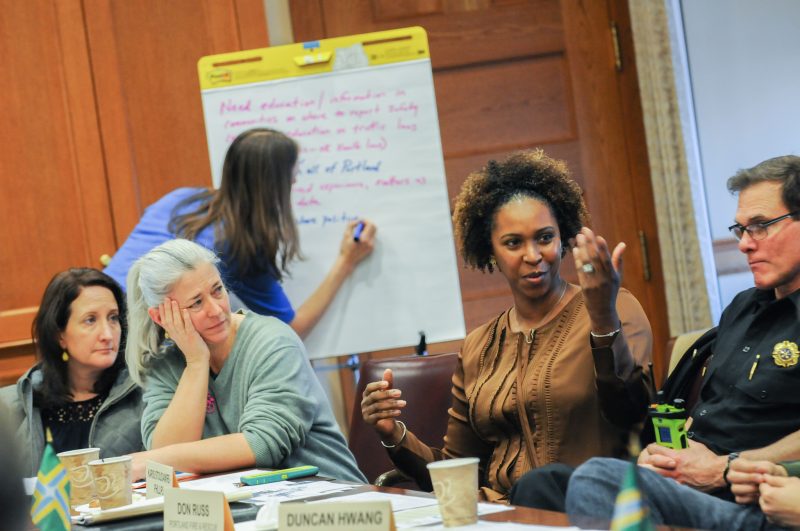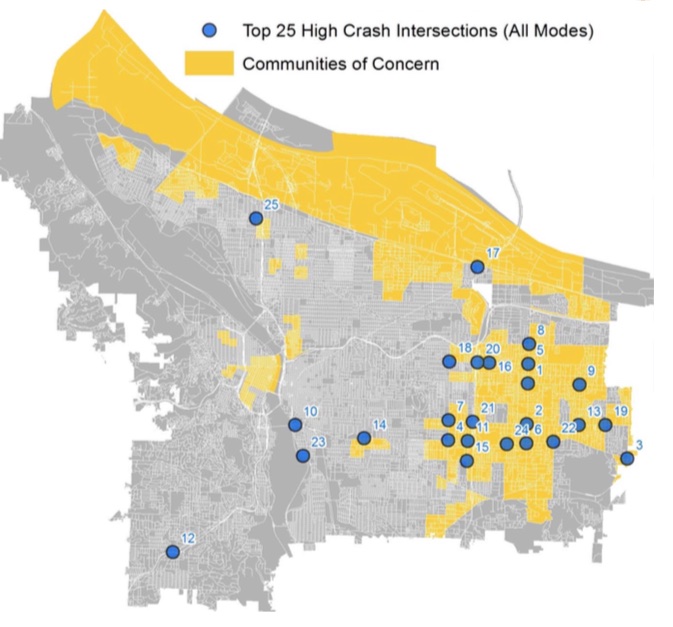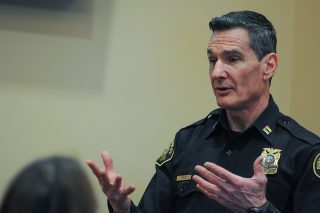
(Photos: J. Maus/BikePortland)
We hear from many of you that it feels like streets in Portland are getting more lawless by the day. One reason is a severe lack of police presence due to a staffing shortage that’s been years in the making. The flip side of that is a concern among traffic safety advocates and the Police Bureau that too much presence in certain parts of the city might lead to unfair or over-policing.
The latest alarm bells over this challenging dynamic came yesterday in City Hall at a meeting of the transportation bureau’s Vision Zero Task Force.
Traffic Division Captain Michael Crebs laid out the current state of traffic enforcement as part of a broader discussion about racial bias from police and road users in general. And newly appointed members of the Task Force laid down some truths about what it’s like to experience racial bias in the right-of-way.
Traffic stops are way down
In 2012, officers from the Traffic Division pulled over 35,133 people. By 2016 (the last year complete data is available) that number had fallen to 19,798. Capt. Crebs said preliminary numbers show that his officers made only about 10,000 stops in 2017.
“On any given day you only have five or maybe six officers actually working traffic patrol.”
— Michael Crebs, Traffic Division Captain.
“A 25,000 stop reduction in a five year period is an awful lot,” Crebs told the Task Force. “And it has everything to do with staffing.”
Keep in mind that Traffic Division officers do the lion’s share of stops for all the things we usually focus on around here like speeding, dangerous turns, and other moving violations. Precint-based patrol officers focus on service calls and crime prevention and reduction. The PPB has about 400 total officers and only 21 of them are Traffic Division officers.
Making matters worse, due to staffing shortages, Crebs said he’s been forced to rotate his officers out of Traffic to cover patrol duties. “25 percent of my officers’ time is spent at a precinct,” he said yesterday. “So in a sense, I have about 16 officers out-and-about at any given time out there enforcing traffic laws.” In 2012 Crebs oversaw 29 officers — nearly double the amount he has now. And the number of officers looking for bad drivers is actually much lower than 16 because they’re spread out into shifts. “On any given day you only have five or maybe six officers actually working traffic patrol,” said Crebs.
That’s five or six officers patrolling tens of thousands of drivers on 4,842 miles of streets in our city — a city that added nearly 60,000 new residents between 2010 and 2016.
Thankfully, due to a local economy that Mayor Ted Wheeler described yesterday as, “More robust then it’s ever been,” the PPB might finally get the funding it needs to staff up. Their latest budget requests $12.3 million to hire 93 new officers — 21 of which The Oregonian reports will help create “walking beats” and other roles to get officers out of their cars and into the community.
Being short on staff isn’t the only enforcement problem Crebs faces. He’s also trying to balance the need for enforcement with concerns around racial bias.
Advertisement
The ‘communities of concern’ conundrum

In the adopted Vision Zero Plan adopted by City Council in 2015 increased enforcement was not a recommended priority because a majority of Task Force members thought it would lead to racial profiling. The conundrum is that the vast majority of dangerous traffic hot-spots are in places PBOT calls “communities of concern” — defined by Census tracts with a higher amount of people of color, low-incomes, poor vehicle access, limited english proficiency, people with disabilities, and older adults and youth.

Here’s how Capt. Crebs laid out his concerns:
“One of my dilemmas is that on the east side of town, 25 of the 30 high crash intersections are directly connected to communities of concern… I want to go out there and give the level of enforcement I want, but I don’t want to over-police. It’s hard to know, where is that balance? If I don’t send my officers out there to engage in enforcement, then we don’t care. If we enforce too much, then we’re over-policing.”
Crebs partners with PBOT on regular Vision Zero enforcement missions and many of them occur in east Portland. So far this year three such missions resulting in 78 citations have occurred east of 82nd Avenue. This might be partially to blame for what Crebs sees as, “An upward trend of African-American and Hispanic drivers being stopped.”
Here’s another slide from Crebs’ presentation showing the race of people stopped:

To the City of Portland’s credit, they have not shied away from the issue of racism in the right-of-way.
Task Force members received a presentation yesterday from the PPB’s Diversity and Equity Manager Elle Weatheroy who outlined the new racial bias trainings all officers must go through. They also heard from PBOT Equity Committee member Irene Schwoffermann who reminded the Task Force that hate crimes are on the rise in Oregon and that Portland is no stranger to racially-motivated street attacks. Task Force member Vivian Satterfield with OPAL Environmental Justice Oregon said their office on SE 82nd Ave has had its windows broken three times — including once during a recent white supremacist march. “Solving all these other issues is not a fair onus to put on our infrastructure,” she said, acknowledging that Vision Zero must go beyond street designs.


The Task Force has also added a member — Nikia Braxton — who lives carfree and came from PBOT’s Walking While Black Focus Group. That group was inspired by the eponymously named research by Kimberly Kahn at Portland State University. Braxton, along with Task Force Members Germaine Flentroy and Karis Stoudamire-Phillips, did not hold back when describing their experiences.
“I lived in Atlanta for 20 years and now I came back and was disappointed,” Braxton said, “I’m learning my neighborhood is not my neighborhood anymore and my streets are not my streets anymore. It all looks great with the new stripes and bike lanes and all that, but we’re not there anymore.”
Braxton grew up in the Albina and Alberta neighborhoods and spoke about how many of her friends and family now live out “in the numbers”. And there’s another thing: “There’s a lot of people that don’t like the fact that these blacks came out to 162nd,” Flentroy added.
Karis Stoudamire-Phillips said after the racially-motivated attacks on a MAX train in Portland last year, she drove everywhere because she felt so vulnerable. “At least once a week somebody says something to me from their car. And at least once a week somebody almost hits me,” she said, “And this happens right here in downtown Portland.”
Hearing and feeling the real stories behind the data is essential if Portland wants to make any significant progress on Vision Zero.
And continued training and evolution at the PPB under the leadership of Capt. Crebs will also be imperative. “Everyone in this room has implicit bias, but the three officers in this room have a higher threshold because we have the authority to seize you and your property,” Crebs shared during his presentation. “It almost brings a tear to my eye thinking that I have to wash that stuff out of my brain as best I can… and I know I can’t completely rid myself of that.”
— Jonathan Maus: (503) 706-8804, @jonathan_maus on Twitter and jonathan@bikeportland.org
Never miss a story. Sign-up for the daily BP Headlines email.
BikePortland needs your support.


